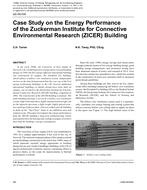Air pollutants, such as particulate matter (PM), volatile organic compounds (VOCs) and oxides of nitrogren (NOx), are the cause of significant health and mortality issues worldwide. These pollutants are not only generated in the outdoor environment and brought indoors, but they can also originate from sources inside as well. At times, indoor air quality can be as poor, or worse, than the air quality of ambient air.
Each and every day, citizens across the globe spend the bulk of their day living, working and sleeping in indoor environments. Indoor building design has evolved to meet many heating and thermal needs for occupants. While the comfort of occupants is of great importance, their health cannot be forgotten. Control measures have been put in place for removing particulates from air streams, but there exists a need for large-scale gaseous pollutant removal.
The challenge with gaseous pollutants is that they are much more difficult to capture on a continuous and cost-effective basis. Additionally, existing technology is hard to apply on a building-wide HVAC scale, cannot handle the immense air loads and is difficult to install in existing HVAC systems.
An air pollution control device (APCD) has been developed to remove NOx, VOCs, and other gaseous pollutants for in-situ and continuous operation in HVAC systems. It is able to be applied for air treatment on a building-wide scale, in both new construction and retrofit applications, and can enhance quality of life for building occupants. This paper will address the design process and development of the APCD.
Citation: 2020 Virtual Conference Papers
Product Details
- Published:
- 2020
- Number of Pages:
- 9
- Units of Measure:
- Dual
- File Size:
- 1 file , 3.5 MB
- Product Code(s):
- D-VC-20-C029

